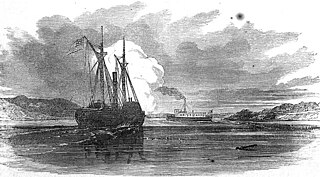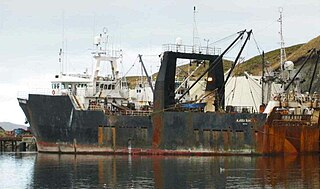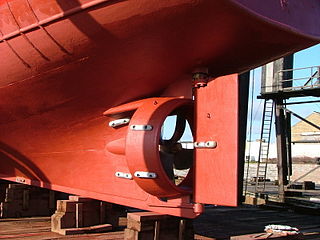
A jet engine is a type of reaction engine discharging a fast-moving jet that generates thrust by jet propulsion. While this broad definition can include rocket, water jet, and hybrid propulsion, the term jet engine typically refers to an internal combustion airbreathing jet engine such as a turbojet, turbofan, ramjet, or pulse jet. In general, jet engines are internal combustion engines.

The turbofan or fanjet is a type of airbreathing jet engine that is widely used in aircraft propulsion. The word "turbofan" is a portmanteau of "turbine" and "fan": the turbo portion refers to a gas turbine engine which achieves mechanical energy from combustion, and the fan, a ducted fan that uses the mechanical energy from the gas turbine to force air rearwards. Thus, whereas all the air taken in by a turbojet passes through the combustion chamber and turbines, in a turbofan some of that air bypasses these components. A turbofan thus can be thought of as a turbojet being used to drive a ducted fan, with both of these contributing to the thrust.

Seamanship is the art, knowledge and competence of operating a ship, boat or other craft on water. The Oxford Dictionary states that seamanship is "The skill, techniques, or practice of handling a ship or boat at sea."

The turbojet is an airbreathing jet engine, typically used in aircraft. It consists of a gas turbine with a propelling nozzle. The gas turbine has an air inlet which includes inlet guide vanes, a compressor, a combustion chamber, and a turbine. The compressed air from the compressor is heated by burning fuel in the combustion chamber and then allowed to expand through the turbine. The turbine exhaust is then expanded in the propelling nozzle where it is accelerated to high speed to provide thrust. Two engineers, Frank Whittle in the United Kingdom and Hans von Ohain in Germany, developed the concept independently into practical engines during the late 1930s.

A tugboat or tug is a marine vessel that manoeuvres other vessels by pushing or pulling them, with direct contact or a tow line. These boats typically tug ships in circumstances where they can or should not move under their own power, such as in crowded harbour or narrow canals, or cannot move at all, such as barges, disabled ships, log rafts, or oil platforms. Some are ocean-going, some are icebreakers or salvage tugs. Early models were powered by steam engines, long ago superseded by diesel engines. Many have deluge gun water jets, which help in firefighting, especially in harbours.

In aeronautics, a ducted fan is a thrust-generating mechanical fan or propeller mounted within a cylindrical duct or shroud. Other terms include ducted propeller or shrouded propeller. When used in vertical takeoff and landing (VTOL) applications it is also known as a shrouded rotor.

The bypass ratio (BPR) of a turbofan engine is the ratio between the mass flow rate of the bypass stream to the mass flow rate entering the core. A 10:1 bypass ratio, for example, means that 10 kg of air passes through the bypass duct for every 1 kg of air passing through the core.

A pump-jet, hydrojet, or water jet is a marine system that produces a jet of water for propulsion. The mechanical arrangement may be a ducted propeller, a centrifugal pump, or a mixed flow pump which is a combination of both centrifugal and axial designs. The design also incorporates an intake to provide water to the pump and a nozzle to direct the flow of water out of the pump.
A propulsor is a mechanical device that gives propulsion. The word is commonly used in the marine vernacular, and implies a mechanical assembly that is more complicated than a propeller. The Kort nozzle, pump-jet and rim-driven thruster are examples.

The Voith Schneider Propeller (VSP) is a specialized marine propulsion system (MPS) manufactured by the Voith Group based on a cyclorotor design. It is highly maneuverable, being able to change the direction of its thrust almost instantaneously. It is widely used on tugs and ferries.

The Kitchen rudder is the familiar name for "Kitchen's Patent Reversing Rudders", a combination rudder and directional propulsion delivery system for relatively slow speed displacement boats which was invented in the early 20th century by John G. A. Kitchen of Lancashire, England. It turns the rudder into a directional thruster, and allows the engine to maintain constant revolutions and direction of drive shaft rotation while altering thrust by use of a control which directs thrust forward or aft. Only the rudder pivots; the propeller itself is on a fixed shaft and does not.

The Pleuger rudder is a power assisted ship's rudder. It creates a flow of water in the direction the rudder points powered by an auxiliary electric motor. This aids maneuverability at low speeds greatly, since it operates on a similar principle to a thruster.

A Schilling rudder is a specific type of profiled rudder used on certain boats and ships.

The Stipa-Caproni, also known as the Caproni Stipa, was an experimental Italian aircraft designed in 1932 by Luigi Stipa (1900–1992) and built by Caproni. It featured a hollow, barrel-shaped fuselage with the engine and propeller completely enclosed by the fuselage—in essence, the whole fuselage was a single ducted fan. Although the Regia Aeronautica was not interested in pursuing development of the Stipa-Caproni, its design influenced the development of jet propulsion.

FV Alaska Ranger was a fishing factory ship owned and operated by the Fishing Company of Alaska of Seattle, Washington. The ship was constructed in 1973 for use as an oil field service vessel. The ship sank 23 March 2008, after reporting progressive flooding only hours earlier. Of the 47 on board, 42 were rescued. Of the five fatalities, four were recovered dead, and one was never found. The Coast Guard was initially misinformed about the number of persons on board the vessel, and secured the search with one crew member still unaccounted for. After realizing there was still one person missing, the Coast Guard reinstated the search, but did not find the crew member.

A ducted propeller, also known as a Kort nozzle, is a marine propeller fitted with a non-rotating nozzle. It is used to improve the efficiency of the propeller and is especially used on heavily loaded propellers or propellers with limited diameter. It was developed first by Luigi Stipa (1931) and later by Ludwig Kort (1934). The Kort nozzle is a shrouded propeller assembly for marine propulsion. The cross-section of the shroud has the form of a foil, and the shroud can offer hydrodynamic advantages over bare propellers, under certain conditions.

Luigi Stipa was an Italian aeronautical, hydraulic, and civil engineer and aircraft designer who invented the "intubed propeller" for aircraft, a concept that some aviation historians view as the predecessor of the turbofan engine.
An airbreathing jet engine is a jet engine that ejects a propelling (reaction) jet of hot exhaust gases after first taking in atmospheric air, followed by compression, heating and expansion back to atmospheric pressure through a nozzle. Alternatively the reaction jet may include a cold jet of ducted bypass air which has been compressed by a fan before returning to atmospheric pressure through an additional nozzle. These engines are gas turbine engines. Engines using only ram for the compression process, and no turbomachinery, are the ramjet and pulsejet.
Kort or KORT may refer to:
An Ice horn, regional named as Ice nose, Ice cutter is a triangular ship constructional part at the stern of a ship. It serves the helm of the ship to protect against unbroken and broken ice, especially when driving astern. The arrangement of the Ice horn should preferably be located in the design waterline.















